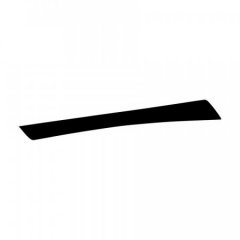Handwriting: The minimum requirements (Part 3)
This series is outdated. I wrote a book about regular script, which I recommend over reading this.
(Continued from Part 2)
In part 2 I introduced to you some things you should look for when observing example characters. To review, they are
- What kind of stroke is employed.
-
In relation to other strokes and components,
- Where it starts
- What it passes through
- Where it ends
[*]In what order it's written
Now we will do some further exercises in observing examples such that good graphemes make it into you head.
First, let's do one exercise regarding length of horizontal strokes. Do you know how to write 三? If you're like most people you probably think the first stroke is longer than the second. Look at these. You should see that they are actually pretty much the same length. If there is any significant difference, then the second stroke is longer. But most importantly, the third stroke is still much longer than the first two. And so here I give you a rule about regular script: In any one character there can be no more than one thing that extends far to the right, and if it's a horizontal stroke, it likely starts on the far left, spanning the whole character. Everything else should usually be much narrower. Therefore, when a character has many uncontained horizontal strokes (i.e. not in 目 or something), pay attention to which one is longest. It will be much longer than the others. Let's examine this in a few more characters.
A close call is not acceptable:




The difference between the longest horizontal stroke and the others must be obvious:




(Verify on 9610.com: 書, 每, 善, 樓.)
And remember, use good examples to make sure the long horizontal stroke is the right one.
華 ←What does that look like to you? Does it look like any of these? Or is it more like
 ?
?
If that looks wrong to you, then you're in good shape, because it should be like
 !
!
Now, remember that the rule says "in any one character there can be no more than one thing that extends far to the right." This thing doesn't have to be a horizontal stroke. It can be a ㇏ or any hook to the upper right, like ㇂ (or 乚). In any character there will be at most one of ㇏ or ㇂ or 乚 or long horizontal strokes. This rule has a name in Chinese: 一字不二捺. You should remember from before that 捺 refers to ㇏, but in this context, it refers to all of ㇏, ㇂, 乚, and long horizontal strokes. If you find yourself writing ㇏ or ㇂ or 乚 and it isn't the rightmost thing in a character, you're probably doing something wrong.
Observe the following wrong characters:





林 contains two 木. You know that 木 ends with a ㇏ but if you write 林, the first one has to change to 丶. If not, two problems will arise: (1) there are more than one ㇏ and (2) there is a ㇏ that is not the rightmost thing of the character. In 疑 there is the ㇏ at the end, but many people like to write a hook on 匕, and if you don't kill it in 疑, you'll end up with both a 乚 and a ㇏. Remember that there can be at most one of these. 輝 has 光 on the left. 光 ends with 乚 when written alone, but because it isn't the rightmost thing in the character, the hook must come off, which results in a bare horizontal end, and because there is more stuff to write to the upper right, this bare horizontal end becomes a ㇀. In 七 there are both a long horizontal stroke and a 乚. Furthermore, 乚 isn't the rightmost thing. And you should remember 大 from Part 2. The problem in this context is that there are both a long horizontal stroke and a ㇏. Observe these characters corrected:





Next, I will show you more rightward-extending things that can't contend for rightwardness with anything else: components like 宀 and 皿.




...the key word being "contend." Notice 宀 being most rightward in 寶, but giving it up in 安 to the 一 in 女. In 孟, there is 子 and 皿, both having long horizontal strokes when written alone, but when written together 皿 dominates. In 盡 we have 聿+火+皿. 聿 and 皿 have long horizontal strokes when written alone, but in 盡, 聿 dominates.
Below I have written the 266 most common characters in Mandarin as further demonstration of this rule. I have circled the rightmost extender in each character if there is one. Sometimes the character doesn't have one, such as when the rightmost thing is a vertical stroke, as in 個. There will be no ㇏, ㇂, 乚, or long horizontal strokes that do not have a red circle (except in 心), unless I have written incorrectly. A blue asterisk means that there are other correct ways of writing the character where a different stroke or component is extended to the right.

Finally, I will show you some characters straight out of my computer that break this rule:

This is DFKai-SB, or 標楷體, which exhibits the standard character forms of the Republic of China.
Quiz question: Do you know how to correct them?
Answer:




(Continued in Part 4)



0 Comments
Recommended Comments
There are no comments to display.